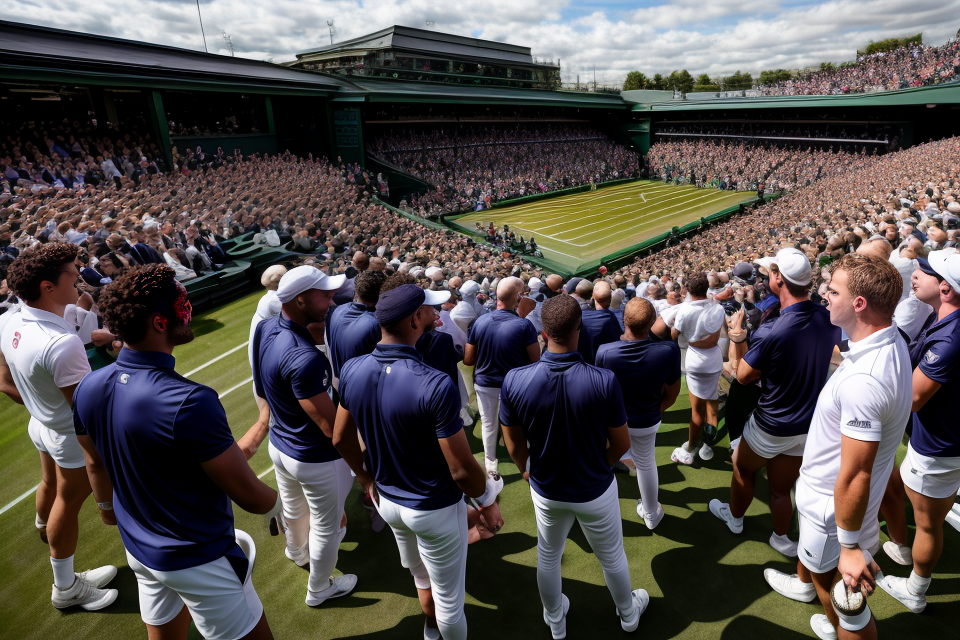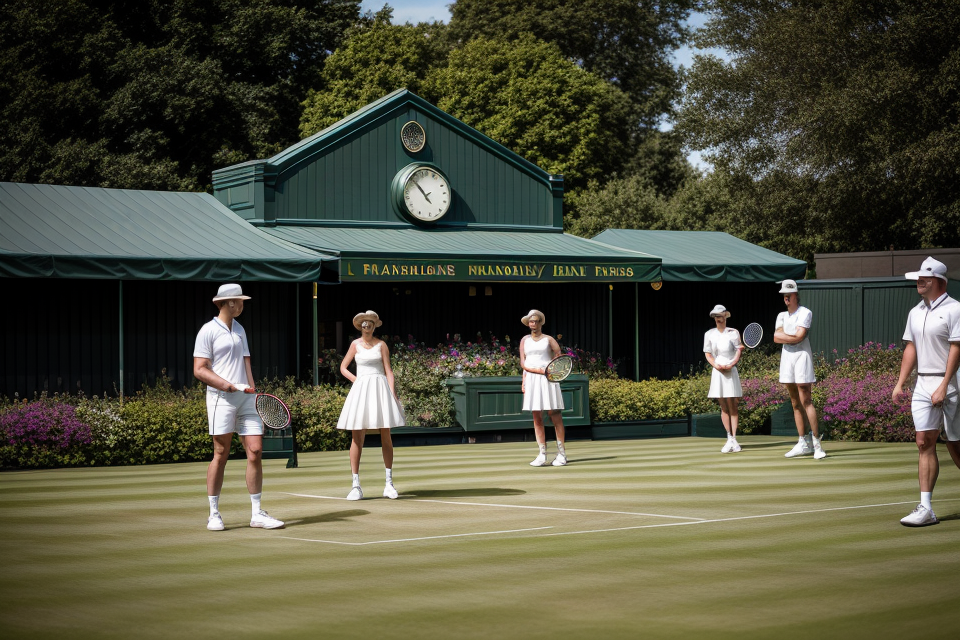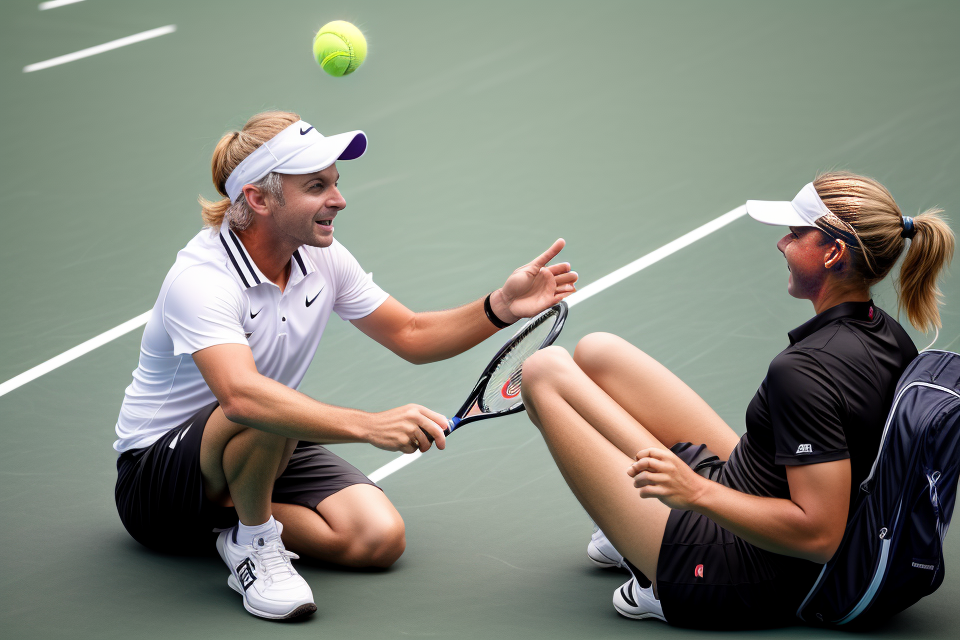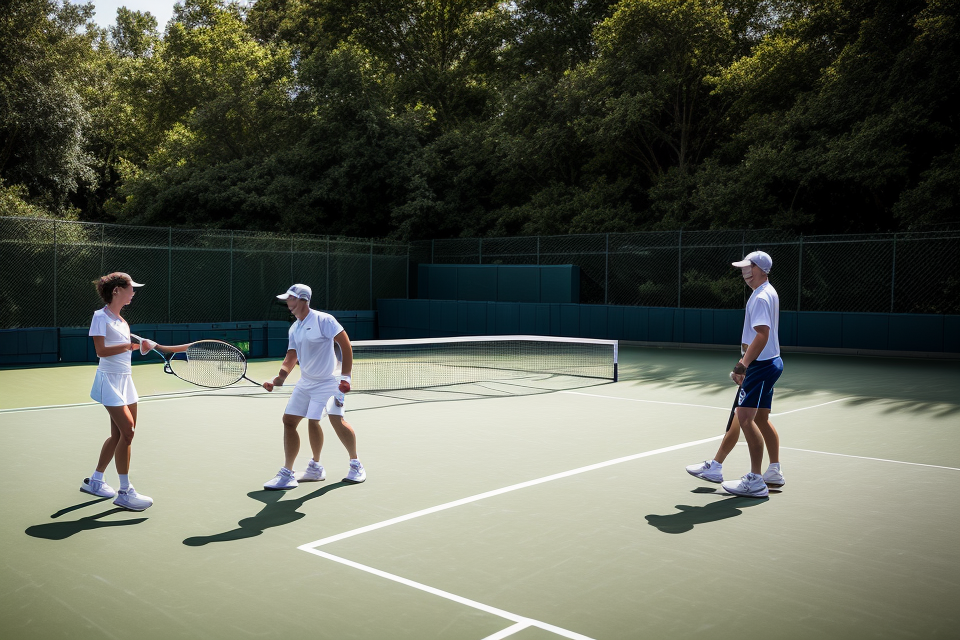As the world’s most prestigious tennis tournament, Wimbledon always captures the attention of millions of sports enthusiasts from around the globe. With its rigorous rules and regulations, it is no surprise that even the coaching aspect of the game is heavily scrutinized. The question on everyone’s mind is – Is coaching allowed at Wimbledon 2023? In this comprehensive guide, we will delve into the intricacies of the coaching rules at Wimbledon and provide a detailed analysis of what is allowed and what isn’t. Get ready to discover the secrets behind the game of tennis and find out how coaches play a vital role in shaping the future of the sport.
Understanding the Allowed Coaching Situations at Wimbledon
The Definition of Coaching
- Giving advice or instruction to a player during a match
- Providing guidance on game tactics, shot selection, or court positioning
- Offering suggestions for improving mental focus or managing stress
- Offering guidance on strategy, technique, or mental preparedness
- Analyzing an opponent’s strengths and weaknesses
- Providing tips for enhancing footwork, swing, or overall performance
- Providing physical assistance, such as holding a towel or a bottle of water
- Offering support during changeovers or breaks in the action
- Helping with equipment, such as adjusting a racquet string or providing a replacement ball
In summary, coaching at Wimbledon 2023 is defined as offering guidance and support to a player during a match. This can include providing advice on strategy, technique, or mental preparedness, as well as offering physical assistance. The purpose of coaching is to help the player improve their performance and achieve their goals on the court.
On-Court Coaching
In tennis, on-court coaching refers to the practice of providing guidance and support to a player during a match while they are still on the court. This type of coaching is highly regulated at Wimbledon to ensure fair play and maintain the integrity of the sport. Here are some of the key details of on-court coaching at Wimbledon:
- Specific Periods for Coaching: Players are allowed to receive coaching during specific periods, such as medical timeouts or between sets. During these times, players can receive guidance from their coaches on strategies, techniques, and mental preparation.
- Communication Methods: Coaches are allowed to communicate with their players through hand signals or written notes. These methods must be discreet and not disrupt the flow of the match.
- Limitations on Coaching Visits: There are limitations on the number of coaching visits per set or match. The number of visits allowed can vary depending on the stage of the tournament and the specific circumstances of the match.
- Restrictions on Coaching Content: Coaches are not allowed to provide any coaching that could be considered tactical advice, such as suggesting specific plays or strategies. They are also prohibited from giving medical advice or treatment to players.
- Consequences of Violating Coaching Rules: Any violation of the coaching rules can result in a code violation, which can lead to a penalty, fine, or disqualification from the tournament.
Overall, on-court coaching is an important aspect of player development and performance in tennis. However, it must be regulated to ensure fair play and maintain the integrity of the sport. Players and coaches must adhere to the rules and guidelines to avoid any consequences and ensure a fair and competitive match.
Off-Court Coaching
Off-court coaching is an essential aspect of a player’s overall development and can provide valuable support throughout their tennis journey. At Wimbledon 2023, the rules regarding off-court coaching are designed to strike a balance between offering players the necessary resources for improvement while maintaining the integrity and fairness of the sport.
- Permitted communication with a player’s coach or support team: During matches, players are allowed to communicate with their coach or support team between sets. This interaction can provide players with strategic advice, moral support, or assistance in dealing with any issues that may arise during the match.
- Utilizing technology, such as video analysis, to review performances and provide feedback: Wimbledon 2023 permits players to use technology to analyze their performances and receive feedback from their coaches. This can include reviewing match footage, analyzing statistical data, or using specialized software to identify areas for improvement. By leveraging technology, players can gain valuable insights into their game and work on specific aspects to enhance their performance.
- Setting up practice sessions or training programs outside of match play: In addition to match days, players are encouraged to engage in off-court practice sessions and training programs with their coaches. These sessions can focus on improving specific skills, building physical endurance, or developing mental toughness. By dedicating time outside of match play to training, players can work towards long-term progress and maintain a consistent level of performance throughout the tournament.
It is essential for players to understand the guidelines and limitations of off-court coaching to ensure compliance with the rules and maintain the spirit of fair competition at Wimbledon 2023.
The Role of Technology in Coaching at Wimbledon
Electronic Communication Devices
Electronic communication devices such as smartphones, tablets, or other devices are permitted for coaching purposes at Wimbledon. However, there are limitations on the types of messages that can be sent and received during a match. Coaches are only allowed to communicate with their players through a designated coaching area and are prohibited from sending any messages that may be deemed as coaching advice.
It is important to note that any breach of the electronic communication rules may result in penalties for both the coach and the player. For instance, if a coach is found to have sent a message that constitutes coaching advice, they may be issued a warning or a penalty point. In severe cases, the umpire may decide to default the match.
Overall, electronic communication devices play a crucial role in coaching at Wimbledon, but it is essential for coaches to adhere to the rules and regulations set forth by the tournament organizers to avoid any penalties or disqualifications.
Video Review Technology
At Wimbledon 2023, the use of video review technology has been implemented to assist coaches in providing their players with the best possible advice. The system allows coaches to review crucial moments in a match, helping them identify areas where their player can improve and providing suggestions for strategy.
Use of Instant Replay Systems
Instant replay systems are used at Wimbledon to review calls made by officials. Coaches can request a review of a call if they believe it to be incorrect. The system allows coaches to view the footage on a large screen, which is located near the court. The coach can then communicate with their player, providing them with advice based on the footage.
Limitations on the Length of Time Allowed for Video Reviews
Coaches are only allowed a limited amount of time to conduct a video review. The length of time allowed for a review varies depending on the situation. For example, a review of a line call can take as little as 10 seconds, while a review of a more complex decision, such as a foot-fault, can take up to 60 seconds.
The Process for Requesting and Conducting Video Reviews
Coaches can request a video review by signaling to the umpire that they would like to challenge a call. The umpire will then initiate the review process, which involves the instant replay system being brought into play. If the call is overturned, the point or game is awarded to the player who was originally due to lose the point or game. If the call is confirmed, the coach must accept the decision and move on.
Overall, the use of video review technology at Wimbledon 2023 has revolutionized the way coaches provide advice to their players. It has added an extra layer of analysis and given coaches more opportunities to help their players improve their game. However, it is important to note that the technology is only a tool and should not be relied upon to make all decisions. Coaches must still use their own expertise and experience to guide their players to success.
Other Technological Innovations
Apart from the previously mentioned technological advancements, such as Hawk-Eye and communication devices, there are several other innovative technologies that have been introduced to enhance coaching at Wimbledon. These cutting-edge tools provide players and coaches with valuable insights and analytics to optimize performance and improve their game strategies.
- Biometric monitoring and data analysis: With the integration of wearable technology, players can now monitor their biometric data, such as heart rate, stroke rate, and other physiological metrics, during matches. This data can be used to analyze performance, identify areas for improvement, and create personalized training programs to enhance physical and mental fitness.
- Virtual reality simulations: Virtual reality (VR) technology has been employed to create immersive training environments where players can practice specific match scenarios, such as serving under pressure or playing in adverse weather conditions. These simulations enable players to develop mental resilience and adaptability, crucial attributes for success at Wimbledon.
- AI-powered coaching tools: Artificial intelligence (AI) has been integrated into coaching tools that analyze player tendencies and predict outcomes based on historical data and performance metrics. These AI-driven systems can provide coaches with personalized recommendations for strategy adjustments, player mental health monitoring, and injury prevention, enabling them to make more informed decisions during matches.
These technological innovations not only enhance the coaching experience at Wimbledon but also provide players with a competitive edge. By leveraging these cutting-edge tools, players can better understand their strengths and weaknesses, develop personalized training programs, and make data-driven decisions on the court.
The Future of Coaching at Wimbledon and Beyond
Embracing Technological Advancements
Exploring new technologies to enhance coaching capabilities
- As technology continues to advance, the world of professional tennis is exploring new ways to leverage innovation in coaching.
- In recent years, coaches have been experimenting with various technologies to gain insights into player performance, improve training regimens, and enhance overall performance.
- From biometric sensors to advanced video analysis tools, coaches now have access to a wide range of technologies that can help them better understand their players and develop customized training programs.
Integrating AI and machine learning to gain deeper insights into player performance
- Artificial intelligence (AI) and machine learning (ML) are increasingly being used in tennis to analyze player performance and provide valuable insights to coaches.
- These technologies can help coaches identify patterns and trends in a player’s performance, such as their strengths and weaknesses, tendencies, and areas for improvement.
- By integrating AI and ML into their coaching strategies, coaches can make more informed decisions about their players’ training, conditioning, and overall development.
Adapting to the evolving landscape of professional tennis
- The world of professional tennis is constantly evolving, and coaches must adapt to keep up with the latest trends and technologies.
- This requires a willingness to embrace change and learn new skills, as well as a deep understanding of the sport and the unique challenges it presents.
- As technology continues to play an increasingly important role in coaching, those who are able to adapt and leverage these tools will be well-positioned to succeed in the fast-paced world of professional tennis.
Maintaining the Integrity of the Sport
As technology continues to advance and reshape the world of sports, it is essential to ensure that the spirit of fair competition remains intact. Maintaining the integrity of the sport is crucial for the credibility and longevity of Wimbledon and other grand slam tournaments.
Balancing the benefits of technological innovation with the spirit of fair competition
The use of technology in coaching has revolutionized the way players train and compete. For instance, players can now access real-time data on their performance, which can help them identify areas for improvement. However, this technology must be used responsibly to avoid giving players an unfair advantage. Therefore, the International Tennis Federation (ITF) has implemented strict guidelines on the use of technology in coaching.
Ensuring that coaching remains within the boundaries of the rules and regulations
Coaches play a crucial role in a player’s success, and their actions on the court must be within the rules and regulations set by the ITF. Any form of coaching that violates these rules can result in penalties, disqualification, or even suspension. It is important for coaches to familiarize themselves with the rules and ensure that they adhere to them throughout the tournament.
Upholding the traditional values of sportsmanship and respect for opponents
Wimbledon is steeped in tradition, and the values of sportsmanship and respect for opponents are deeply ingrained in the tournament’s history. Coaches must lead by example and instill these values in their players. This includes respecting the umpire’s decisions, showing courtesy to opponents, and maintaining a professional demeanor throughout the tournament.
In conclusion, maintaining the integrity of the sport is crucial for the success and longevity of Wimbledon and other grand slam tournaments. By balancing the benefits of technological innovation with the spirit of fair competition, ensuring that coaching remains within the boundaries of the rules and regulations, and upholding the traditional values of sportsmanship and respect for opponents, Wimbledon can continue to be a beacon of excellence in the world of tennis.
Addressing the Challenges and Opportunities of Coaching in Modern Tennis
- Adapting to the diverse skill sets and styles of contemporary players
- Preparing for the next generation of talent, armed with advanced training and technology
- Continuously refining the rules and guidelines to maintain the highest standards in the sport
Adapting to the Diverse Skill Sets and Styles of Contemporary Players
- Recognizing the varying physical attributes and mental approaches of today’s players
- Understanding the importance of individualized coaching strategies
- Fostering a holistic approach to player development, including mental, physical, and tactical aspects
- Encouraging open communication between coaches, players, and support staff to create a collaborative learning environment
- Utilizing advanced technologies, such as biomechanical analysis and predictive analytics, to enhance player performance
- Integrating data-driven insights into coaching methodologies
- Adapting to the growing trend of multi-coaching, where a single coach oversees multiple players
- Navigating the challenges of cultural diversity and language barriers among players from different backgrounds
- Developing specialized coaching programs for seniors, juniors, and disabled athletes
- Encouraging lifelong learning and continuous professional development for coaches
- Promoting a healthy work-life balance for coaches to prevent burnout and maintain high-quality coaching
Preparing for the Next Generation of Talent, Armed with Advanced Training and Technology
- Anticipating the next wave of innovations in training and equipment
- Staying informed about the latest advancements in sports science and technology
- Identifying and addressing potential ethical concerns related to the use of technology in coaching
- Integrating virtual reality and augmented reality tools into coaching sessions
- Exploring the possibilities of genetic testing and gene editing to enhance player performance
- Understanding the implications of artificial intelligence and machine learning for coaching strategies
- Adapting to the growing trend of remote coaching, enabled by digital communication platforms
- Encouraging young coaches to develop expertise in multiple areas, such as sports psychology, nutrition, and strength and conditioning
- Providing mentorship and networking opportunities for aspiring coaches
- Developing sustainable coaching practices that align with the principles of environmental stewardship
Continuously Refining the Rules and Guidelines to Maintain the Highest Standards in the Sport
- Reviewing and updating coaching regulations to address evolving concerns, such as player safety and fair play
- Encouraging a culture of transparency and accountability among coaches
- Developing clear guidelines for coaches regarding their roles and responsibilities
- Ensuring that coaching practices align with the values and ethics of the sport
- Fostering a culture of collaboration and knowledge sharing among coaches, officials, and players
- Establishing standards for coach education and certification
- Promoting a culture of ongoing evaluation and improvement for coaches and their coaching practices
- Developing mechanisms for addressing misconduct and abuse within the coaching profession
- Supporting the professional growth and development of coaches through continuous learning opportunities
- Encouraging a holistic approach to athlete development that prioritizes health, well-being, and long-term success
FAQs
1. What are the coaching rules at Wimbledon 2023?
The All England Lawn Tennis Club (AELTC) has implemented strict coaching rules at Wimbledon 2023. During a match, a player is only allowed to receive coaching from their designated coach, who must be approved by the AELTC. The coach must remain off the court and is only allowed to communicate with the player via phone or radio, with a 15-second time limit for each call. Coaching is only permitted during the first 10 minutes of a match, and the player must inform the umpire if they plan to use this option.
2. Can players use coaching during practice sessions?
Yes, players are allowed to receive coaching during practice sessions. However, they are not allowed to use any electronic devices, such as smartphones or tablets, to communicate with their coaches. Coaches are also not allowed to use any electronic devices to communicate with players during practice sessions.
3. What happens if a player receives coaching during a match?
If a player receives coaching during a match, the umpire will issue a warning. If the player continues to receive coaching, they will be defaulted from the match. In addition, if a coach is found to be providing coaching during a match, they may be banned from the tournament.
4. Are there any exceptions to the coaching rules?
Yes, there are exceptions to the coaching rules for players with disabilities. Players with disabilities are allowed to receive coaching from their designated coach on court during a match, as long as the coach remains off the court and does not interfere with the play.
5. Can players use sports technology during matches?
Yes, players are allowed to use sports technology during matches, as long as it is approved by the AELTC. This includes electronic line calling, which is used to determine whether a ball is in or out, and medical time-outs, which allow players to receive treatment for injuries. However, players are not allowed to use any other electronic devices, such as smartphones or tablets, during matches.



